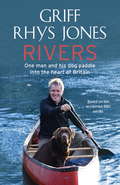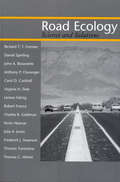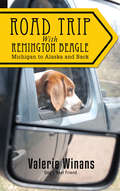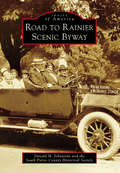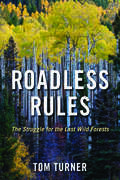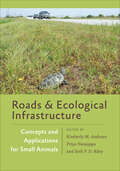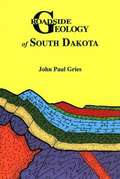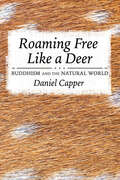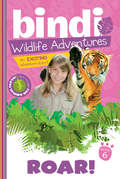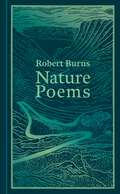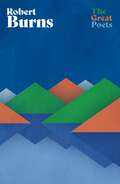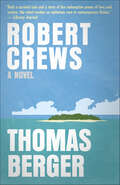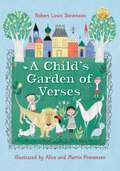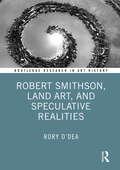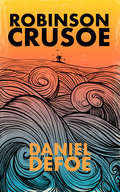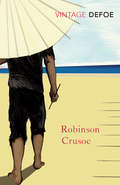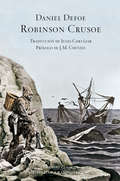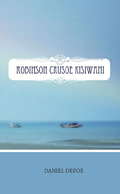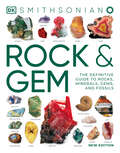- Table View
- List View
Rivers: One Man And His Dog Paddle Into The Heart Of Britain
by Griff Rhys JonesIn punts canoes and rowing boats, Griff Rhys Jones takes us on a tour of Britain's beautiful and extraordinary rivers. He battles through the gorges and waterfalls of Scotland's wild mountains, drifts across the plains of East Anglia and plunges into the Wye, exploring the legends and stories of our rivers on the way. How did man harness the power of water in feats of engineering like the Manchester Ship Canal, or the fountains at Chatsworth pr the weirs of Hertfordshire? What's it like to fall through a canyon in the Highlands, snorkel through a bog, slalom down a rapid or ride the Severn Bore? How were rivers an inspiration for Constable and the hermits of Bridgnorth? Griff investigates the love affair between cities and rivers from Liverpool's Mersey to London's Lea. From reminiscing about childhood holidays on the Suffolk Stour to taking the plunge on a wintry morning in the Tay as it rushes through Perth, Griff shares his person journeys along the river systems of Britain - always accompanied by Cadbury the faithful water dog.
Rivers: One man and his dog paddle into the heart of Britain
by Griff Rhys JonesIn punts canoes and rowing boats, Griff Rhys Jones takes us on a tour of Britain's beautiful and extraordinary rivers. He battles through the gorges and waterfalls of Scotland's wild mountains, drifts across the plains of East Anglia and plunges into the Wye, exploring the legends and stories of our rivers on the way. How did man harness the power of water in feats of engineering like the Manchester Ship Canal, or the fountains at Chatsworth pr the weirs of Hertfordshire? What's it like to fall through a canyon in the Highlands, snorkel through a bog, slalom down a rapid or ride the Severn Bore? How were rivers an inspiration for Constable and the hermits of Bridgnorth? Griff investigates the love affair between cities and rivers from Liverpool's Mersey to London's Lea. From reminiscing about childhood holidays on the Suffolk Stour to taking the plunge on a wintry morning in the Tay as it rushes through Perth, Griff shares his person journeys along the river systems of Britain - always accompanied by Cadbury the faithful water dog.
Road Ecology: Science and Solutions
by Virginia H. Dale Daniel Sperling Anthony P. Clevenger Richard T.T. Forman Carol D. Cutshall John A. BissonetteA central goal of transportation is the delivery of safe and efficient services with minimal environmental impact. In practice, though, human mobility has flourished while nature has suffered. Awareness of the environmental impacts of roads is increasing, yet information remains scarce for those interested in studying, understanding, or minimizing the ecological effects of roads and vehicles. Road Ecology addresses that shortcoming by elevating previously localized and fragmented knowledge into a broad and inclusive framework for understanding and developing solutions. The book brings together fourteen leading ecologists and transportation experts to articulate state-of-the-science road ecology principles, and presents specific examples that demonstrate the application of those principles. Diverse theories, concepts, and models in the new field of road ecology are integrated to establish a coherent framework for transportation policy, planning, and projects. Topics examined include: *foundations of road ecology *roads, vehicles, and transportation planning *vegetation and roadsides *wildlife populations and mitigation *water, sediment, and chemical flows *aquatic ecosystems *wind, noise, and atmospheric effects *road networks and landscape fragmentationRoad Ecology links ecological theories and concepts with transportation planning, engineering, and travel behavior. With more than 100 illustrations and examples from around the world, it is an indispensable and pioneering work for anyone involved with transportation, including practitioners and planners in state and province transportation departments, federal agencies, and nongovernmental organizations. The book also opens up an important new research frontier for ecologists.
Road Trip 13000 feet: रोड ट्रिप १३००० फीट
by Devendra Pandeyतीन अनजाने जो मित्र बने। पहली मुलाकात और पहली ही मुलाकात में रोड ट्रिप की योजना, तीन यात्राएं, तीन पड़ाव, तीन कहानियां, लेकिन मंजिल एक। जिंदगी की परेशानियों और उलझनों से जूझ रहे तीन अनजाने दुनिया जहान को भुला कर एक अनोखे सफर पर निकल पड़े, एक ऐसे अनुभव के लिए जिसने उन्हें बदल कर रख दिया। यात्रा जो मुम्बई के मैदानों से आरम्भ होकर उत्तराखंड की बर्फीली चोटियों तक पहुंच जाती है, जहां उनका सामना उनकी नियति से होता है। नियति जो जीवन मरन से परे जाकर उनके अस्तित्व को ही बदल कर रख देती है। रास्तों में मंजिल खोजने की कहानी।
Road Trip with Remington Beagle: Michigan to Alaska and Back
by Valerie WinansTake a road trip with me, Remington Beagle, from Traverse City, Michigan to various destinations in Alaska. As the head beagle in charge of this adventure, I will guide the reader along the famous Alaska Highway (also known as the Alcan). This recreational vehicle journey continues on some of the most scenic and exciting roads on the continent making this a unique travel log for people who love camping and storytelling beagles. This Alaska joyride takes us as far north as Barrow, Alaska (the most northern community on the North American Continent) to Homer, Alaska in the south and destinations in between. As you ramble with us along these roads and share the Alaska experience from a dog's eye view, you will be enticed to make this trek on your own. I will be happy to join you as I never tire of neither the Alaska experience nor the roads that take me there.
Road to Rainier Scenic Byway (Images of America)
by Donald M. Johnstone the South Pierce County Historical SocietyThe Road to Rainier Scenic Byway has grown from a Native American forest trail, hundreds of years old, to a modern forest highway carrying 1.5 million travelers a year. In 1833, a European tourist first reached a glacier, and soon others followed, seeking the wonders of Mount Rainier. In 1903, the railroad reached Eatonville; and national park visitors, who started as a few thousand, became tens of thousands. With a market for timber, hundreds rushed to claim the lands. Forestry and tourism both thrived off the rich natural resources, and as the region developed, purely commercial ventures were supplemented with educational outreach. Charles L. Pack Experimental Forest, established in 1926, conducts scientific research into forest management and sustainability. Historical interpretation has become a function of the Mount Rainier Scenic Railroad and Logging Museum. The Road to Rainier Scenic Byway continues to serve all as it heads to scenic Mount Rainier.
Roadless Rules: The Struggle for the Last Wild Forests
by Tom TurnerRoadless Rules is a fast-paced and insightful look at one of the most important, wide-ranging, and controversial efforts to protect public forests ever undertaken in the United States. In January 2000, President Clinton submitted to the Federal Register the Roadless Area Conservation Rule, prohibiting road construction and timberharvesting in designated roadless areas. Set to take effect sixty days after Clinton left office, the rule was immediately challenged by nine lawsuits from states, counties, off-road-vehicle users, and timber companies. The Bush administration refused to defend the rule and eventually sought to replace it with a rule that invited governors to suggest management policies for forests in their states. That rule was attacked by four states and twenty environmental groups and declared illegal. Roadless Rules offers a fascinating overview of the creation of the Clinton roadless rule and the Bush administration's subsequent replacement rule, the controversy generated, the response of the environmental community, and the legal battles that continue to rage more than seven years later. It explores the value of roadless areas and why the Clinton rule was so important to environmentalists, describes the stakeholder groups involved, and takes readers into courtrooms across the country to hear critical arguments. Author Tom Turner considers the lessons learned from the controversy, arguing that the episode represents an excellent example of how the system can work when all elements of the environmental movement work together--local groups and individuals determined to save favorite places, national organizations that represent local interests but also concern themselves with national policies, members of the executive branch who try to serve the public interest but need support from outside, and national organizations that use the legal system to support progress achieved through legislation or executive action.
Roads and Ecological Infrastructure: Concepts and Applications for Small Animals (Wildlife Management and Conservation)
by Kimberly M. Andrews, Priya Nanjappa and Seth P. D. RileyA practical guide that explains how we can design roads that are compatible with populations of small wildlife.Few of us think twice about driving on roads. Yet the very presence of roads and the act of driving on them can impact the ecological infrastructure that supports an animal's daily life. What chance does a turtle have of successfully laying its eggs when it needs to traverse a busy highway? Is it realistic to expect small mammals to breed when an interstate thoroughfare subdivides their population? These are the sorts of challenges faced by small, often slow-moving, animals, challenges that road engineers and ecologists are trying to address.For countless small species, vehicles traveling at high speeds are nothing less than missiles shooting across migration pathways. For too many animals, the danger can lead to the loss of populations, in part because they simply are not programmed to react to traffic. Salamanders faced with a two-lane road between the forest and their aquatic breeding site, for example, will typically cross that road regardless of the congestion. The result can be hundreds of flattened animals in a single night.Roads and Ecological Infrastructure is the first book to focus on reducing conflict between roads and small animals. Highlighting habitat connections and the challenges and solutions from both transportation and ecological perspectives, the volume covers various themes, including animal behavior related to roads and design approaches to mitigate the negative effects of roads on wildlife. The chapter authors—from transportation experts to university researchers—each promote a goal of realistic problem solving. Conceptual and practical, this book will influence the next decade or more of road design in ecologically sensitive areas and should prevent countless unnecessary wildlife fatalities.Published in association with The Wildlife Society.
Roadside Geology of South Dakota
by John P. Gries James GriesemerA layperson's geological road map describing rocks and landforms along South Dakota's highways, as well as the geology lying beneath in caves and mine shafts. Gries (geology, South Dakota School of Mines) keeps it simple but informative, traveling from the glaciated prairies, across the Missouri River, and into the rugged Badlands Wall, the Needles, and the Homestake gold mine in the the West. Stops along the way include geologic tours of the Black Hills, Mount Rushmore, Wind Cave National Park, and Jewel Cave National Monument. Includes maps and photographs. Annotation c. by Book News, Inc., Portland, Or.
Roaming Free Like a Deer: Buddhism and the Natural World
by Daniel CapperBy exploring lived ecological experiences across seven Buddhist worlds from ancient India to the contemporary West, Roaming Free Like a Deer provides a comprehensive, critical, and innovative examination of the theories, practices, and real-world results of Buddhist environmental ethics. Daniel Capper clarifies crucial contours of Buddhist vegetarianism or meat eating, nature mysticism, and cultural speculations about spirituality in nonhuman animals. Buddhist environmental ethics often are touted as useful weapons in the fight against climate change. However, two formidable but often overlooked problems with this perspective exist. First, much of the literature on Buddhist environmental ethics uncritically embraces Buddhist ideals without examining the real-world impacts of those ideals, thereby sometimes ignoring difficulties in terms of practical applications. Moreover, for some understandable but still troublesome reasons, Buddhists from different schools follow their own environmental ideals without conversing with other Buddhists, thereby minimizing the abilities of Buddhists to act in concert on issues such as climate change that demand coordinated large-scale human responses. With its accessible style and personhood ethics orientation, Roaming Free Like a Deer should appeal to anyone who is concerned with how human beings interact with the nonhuman environment.
Roar!
by Bindi IrwinBindi, Robert and Terri Irwin are on their way to Sumatra to collect three gorgeous tiger cubs to take back with them to Australia Zoo. Soon after they are introduced to the mischievous trio, Bindi and her new friend Madi get involved in tracking down a nefarious gang of tiger poachers.
Robert Burns - Nature Poems
by Robert BurnsThis enchanting collection of more than 80 poems captures the essence of the natural world, as seen through the eyes of Scotland's beloved bard. Each chapter explores a different aspect of nature - from wild, mossy mountains and glens to murmuring streams, the sorrowful song of the woodlark, and the ever-changing seasons. Burns's profound appreciation for the landscape of Scotland and its creatures shines through every verse, and this collection is a heartfelt love letter to his homeland. Whether you're a long-time admirer of Burns or discovering his work for the first time, Nature Poems will transport you to the heart of Scotland's natural splendour.Illustrated by local artist, The Ink Bothy, and compiled by Scottish resident and poet Robert Tuesley Anderson, this is a collection to treasure.
Robert Burns - Nature Poems
by Robert BurnsThis enchanting collection of more than 80 poems captures the essence of the natural world, as seen through the eyes of Scotland's beloved bard. Each chapter explores a different aspect of nature - from wild, mossy mountains and glens to murmuring streams, the sorrowful song of the woodlark, and the ever-changing seasons. Burns's profound appreciation for the landscape of Scotland and its creatures shines through every verse, and this collection is a heartfelt love letter to his homeland. Whether you're a long-time admirer of Burns or discovering his work for the first time, Nature Poems will transport you to the heart of Scotland's natural splendour.Illustrated by local artist, The Ink Bothy, and compiled by Scottish resident and poet Robert Tuesley Anderson, this is a collection to treasure.
Robert Burns: A superb collection from Scotland’s finest lyrical poet (The Great Poets)
by Robert Burns'Oh would some power the gift give us, to see ourselves as others see us!' Robert BurnsRobert Burns, poet and lyricist, also known as Rabbie Burns, is widely regarded as the National Poet of Scotland - and much of his work has become part of everyday modern language:'The best laid schemes o' mice and men...''To see her is to love her...'Often credited with writing the lyrics for Auld Lang Syne, he almost single-handedly inspired the movement that preserved Scottish music and lyrics which had been handed down the generations vocally for centuries, thereby maintaining Scots culture and language.A cultural icon and pioneer of the Romantic movement, Burns was chosen as the greatest Scot in a 2009 poll. This collection includes some of his best-loved, most beautiful work.'Now's the day, now's the hour' Robert Burns
Robert Burns: A superb collection from Scotland’s finest lyrical poet (The Great Poets)
by Robert Burns'Oh would some power the gift give us, to see ourselves as others see us!' Robert BurnsRobert Burns, poet and lyricist, also known as Rabbie Burns, is widely regarded as the National Poet of Scotland - and much of his work has become part of everyday modern language:'The best laid schemes o' mice and men...''To see her is to love her...'Often credited with writing the lyrics for Auld Lang Syne, he almost single-handedly inspired the movement that preserved Scottish music and lyrics which had been handed down the generations vocally for centuries, thereby maintaining Scots culture and language.A cultural icon and pioneer of the Romantic movement, Burns was chosen as the greatest Scot in a 2009 poll. This collection includes some of his best-loved, most beautiful work.'Now's the day, now's the hour' Robert Burns
Robert Crews: A Novel
by Thomas BergerFrom the author of Little Big Man comes a modern retelling of Robinson Crusoe that is an introspective look at the human condition only Thomas Berger could deliver. “Both a survival tale and a story of the redemptive power of love and nature, the novel exudes an optimism rare in contemporary fiction.” —Library Journal On a fishing expedition with one friend he can barely tolerate and two other men he barely knows, Robert Crews is content to spend the entirety of the flight in the alcoholic haze he’s all too familiar with. But when the turbulence becomes something more, it’s clear that something is wrong. Crash landing in unfamiliar territory, Crews is the sole survivor to emerge from the wreckage. Alone, and without a drop of alcohol for the first time in his life, he must face the wild and, worse—himself. Crews salvages what’s left of his companion’s survival gear from the plane, learns to build his first fire, and fashions a makeshift shelter from the elements. Alone with his memories, Crews begins to lament the years he spent wandering aimlessly through life, unable to attach himself to a single thing, or a single person. His new lessons in self-care and human understanding pick up the pace when he suddenly encounters a woman on the run from her violent husband. Sparking new feelings of compassion, protectiveness, and genuine love in Crews, he allows Friday to join him on the search for civilization—all while avoiding the husband that seems bent on getting Friday back into his abusive grasp. Even in their return to civilization, Berger crafts a conclusion that sets this surprisingly tender retelling apart from every other tribute to Crusoe.
Robert Louis Stevenson's A Child's Garden of Verses
by Robert Louis StevensonHow do you like to go up in a swing, Up in the air so blue? Oh, I do think it the pleasantest thing Ever a child can do! Robert Louis Stevenson&’s rhymes have charmed children and adults alike since 1885, when they first appeared to a delighted public. Stevenson&’s joyful exploration of the world speaks directly from a child&’s point of view and celebrates the child&’s imagination. This Golden Books edition, originally published in 1951, features lively, colorful illustrations by Caldecott Medalists Alice and Martin Provensen. The original artwork has been digitally restored for this edition—resulting in a stunning, best-ever reproduction!
Robert Smithson, Land Art, and Speculative Realities (Routledge Research in Art History)
by Rory O'DeaThis book explores the ways Robert Smithson’s art revealed and defamiliarized the constructs of rational reality in order to allow radically speculative alternatives to emerge. In this way, his art is conceived as a true fiction that eradicates a false reality. By tracing the web of correspondences between Smithson and science fictional, speculative and mystical modes of thought, Rory O’Dea explores the aesthetic encounters engendered by his art as a means to warp the contours of reality and loosen the boundaries of being human. Given the current and impending catastrophes of the Anthropocene, which represents the ever-expanding planetary shadow cast by humanism, the possibility of being other-than-human posited by Smithson’s art is a matter of urgent concern. The book will be of interest to scholars working in art history, contemporary art, American studies and environmental humanities.
Robin at Hickory Street (Backyard Books)
by Dana Meachen RauWhile searching for a new home where he can begin a family, Robin often hears "no vacancy" and "no trespassing" chirped at him. Pictures are described. Robin at Hickory Street is one of the SMITHSONIAN'S BACKYARD books, a series of books to excite children about animals they might see outside their windows developed by National Museum of Natural History (a Smithsonian Institution Museum). It is a colorful science book for children from preschool through second grade.
Robinson Crusoe
by Daniel DefoeRobinson Crusoe runs away from home to join the navy. After a series of adventures at sea, he is shipwrecked in a devastating storm, and finds himself alone on a remote desert island. He remains there many years, building a life for himself in solitude, until the day he discovers another man’s footprint in the sand . . .Penguin Random House Canada is proud to bring you classic works of literature in e-book form, with the highest quality production values. Find more today and rediscover books you never knew you loved.
Robinson Crusoe
by Daniel DefoeDiscover the legendary story of a marine adventurer shipwrecked on a desert island. Robinson Crusoe runs away from home to join the navy. After a series of adventures at sea, he is shipwrecked in a devastating storm, and finds himself alone on a remote desert island. He remains there many years, building a life for himself in solitude, until the day he discovers another man's footprint in the sand... ‘Robinson Crusoe has a universal appeal, a story that goes right to the core of existence’ Guardian
Robinson Crusoe (edición ilustrada): Aus, The Life And Surprising Adventures Of Robinson Crusoe Of York, Mariner (1893)
by Daniel DefoeLa colección Grandes Clásicos Literatura Random House nos trae esta exquisita edición de Robinson Crusoe con ilustraciones del caricaturista francés J.J. Grandville (1803-1847) y prologada por J.M. Coetzee. Robinson Crusoe, publicada en 1719, inaugura en Inglaterra la novela moderna y, a lo largo de los siglos, sus personajes han ingresado en la restringida familia de los arquetipos imperecederos. «Como Odiseo en su singladura hacia Ítala -nos dice J.M. Coetzee en el prólogo- o como el Quijote montado sobre Rocinante, Robinson Crusoe, con su loro y su sombrilla, se ha convertido en un personaje de la conciencia colectiva de Occidente que trasciende al libro en el que se celebran sus aventuras. Tras haber aspirado a pertenecer a la Historia, se ha encontrado inmerso en la esfera del mito.» Esta edición, que reúne las dos partes del clásico con ilustraciones de la época, recupera también la espléndida traducción de uno de nuestros clásicos contemporáneos, Julio Cortázar. «La verdadera grandeza de una vida consiste en llegar a ser el dueño de uno mismo.»
Rock & Gem
by DKYour compact guide to more than 450 rocks, crystals, gemstones, and fossilsExplore the treasures of the Earth—sparkling crystals, vibrant gemstones, and age-old fossils—with this illustrated guide that's sure to captivate every rockhound and budding gemmologist.From primeval origins to their astonishing modern-day uses and appeal, this is the ultimate portrait of Earth's geological riches. Also included is a focused look at other precious materials often prized for their beauty, such as amber, coral, ivory, and fossils.Learn how to identify more than 450 rock and gem specimens through stunning photographs and detailed characteristics. Discover more about rocks and gems through folklore and historical artifacts and find out the fascinating stories behind some of the amazing natural treasures, including the Hope Diamond and the Great Mogul emerald. It also contains information on polishing and displaying your finds to further equip you with all the knowledge needed to delve into the arena of rock and mineral collecting.Rocks & Gems was produced in association with the Smithsonian in Washington, D.C., the world's largest museum complex, ensuring the guide's accuracy.
Rock Climbing
by Larry Dane BrimnerPresents a brief description of rock climbing, a sport that requires little equipment, appeals to all ages, and is considered to be mental as well as physical.
